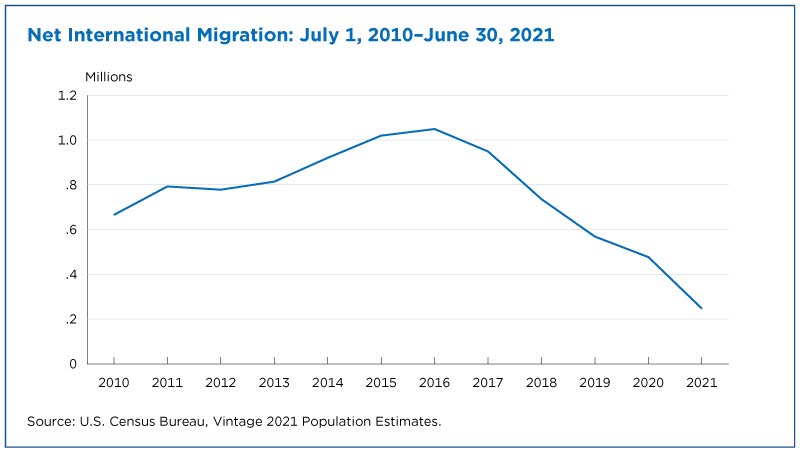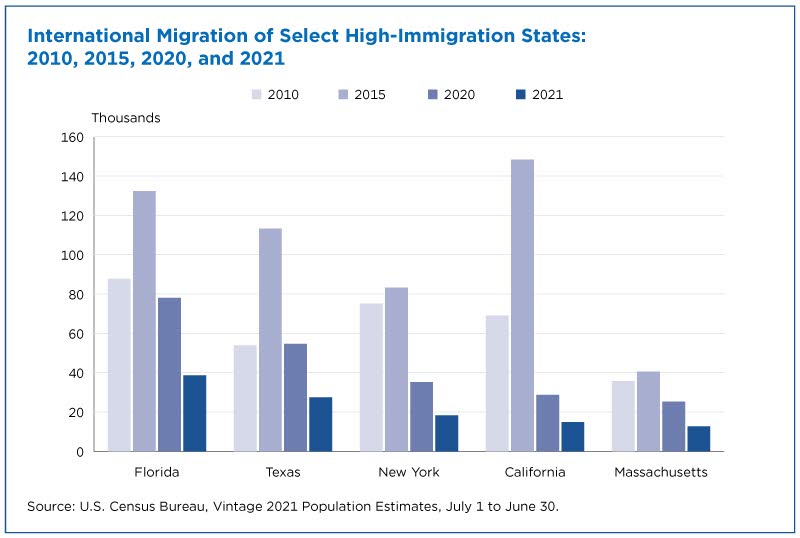New Population Estimates Show COVID-19 Pandemic Significantly Disrupted Migration Across Borders
The COVID-19 pandemic significantly impacted international migration patterns both to and from the United States, resulting in the lowest levels of international migration in decades and affecting the data typically used to measure migration flows.
Net international migration (NIM) added 247,000 to the nation's population between 2020 and 2021, according to U.S. Census Bureau July 1, 2021 population estimates released today.
For example, through June 2021, land borders between the United States, Mexico and Canada remained closed to non-essential travel and three-fourths of U.S. consulates abroad, which issue visas, remained closed.
This is a notable drop from last decade’s high of 1,049,000 between 2015 and 2016. This is also lower than the 477,000 added between 2019 and 2020, which overlapped with the start of the COVID-19 pandemic.
Most COVID restrictions remained in place over the 2021 estimates year (July 1, 2020-June 30, 2021), greatly reducing the movement of people to and from the country.
For example, through June 2021, land borders between the United States, Mexico and Canada remained closed to non-essential travel and three-fourths of U.S. consulates abroad, which issue visas, remained closed.
Travel restrictions from certain countries remained in place and despite changes in immigration policies, the tremendous backlog for issuing visas and settling refugees continued.
All these disruptions required an adjustment to our NIM estimates to reflect the impact of COVID-19 on international migration.
Using publicly available administrative data sources, we adjusted our American Community Survey (ACS)-based NIM estimates based on trends seen with these data, which more accurately reflected migration patterns during the pandemic period. This resulted in the lowest NIM totals in decades.
International Migration Trends
After last decade’s peak from 2015 to 2016, NIM declined between 2016 and 2019, reflecting three major trends:
- Declining immigration of the foreign born.
- Increasing emigration of the foreign born.
- Changes in Puerto Rican migration following Hurricane Maria in September 2017.
The decline in NIM since 2020 can be attributed in part to the COVID-19 pandemic and associated changes in migration policy.

Florida, Texas, New York, California, and Massachusetts typically gain the most migrants from abroad and comprise about half of NIM for the nation most years.
All five of these states saw decreases in NIM between 2015 and 2021, including a nearly 50% drop from 2020 to 2021.
California experienced the largest decline of these states (both in numeric and percent change) from 148,000 in 2015 to 15,000 in 2021.
Adjusting Methodology for COVID-19
In addition to reducing levels of migration, the pandemic also affected data collection. It had a particularly significant impact on the 2020 ACS, which would have been the basis for most of our Vintage 2021 NIM estimates.
The ACS sample was greatly reduced — one-third of the interviewed survey sample was lost — after the start of the COVID-19 pandemic, which disproportionately affected certain groups and resulted in nonresponse bias in the estimates for the foreign born.
The data collection issues experienced by the 2020 ACS severely affected data quality, so the Census Bureau only released experimental estimates from the 1-year data.
As a result, we decided the 2020 ACS was not a good fit for our purposes, and instead adjusted 2019 ACS data based on trends noted in administrative data between 2019 and 2021.
Administrative sources used included data from the U.S. Department of Justice, the Institute of International Education, the U.S. Citizenship and Immigration Services and the U.S. State Department Bureau of Consular Affairs and Refugee Processing Center.
Data are available for download.
Given immigration trends seen in 2019-2021 administrative data and the strong historical relationship between these data and foreign-born immigration ACS estimates, we reduced our 2019 ACS-based estimate by the same degree.
The adjustment factor was created by calculating the percent difference between administrative sources measuring immigration in estimates years 2019 and 2021.
This provided a reasonable adjustment for our foreign-born immigration component, which we then applied to other NIM components (excluding net migration between the United States and Puerto Rico).
We worked under the assumption that the reduction in immigration during the pandemic also applied to both foreign-born emigration and net native migration.
DATA GEMS: How We Estimate the Population in the United States
Related Statistics
Subscribe
Our email newsletter is sent out on the day we publish a story. Get an alert directly in your inbox to read, share and blog about our newest stories.
Contact our Public Information Office for media inquiries or interviews.
-
America Counts StoryNet Outmigration from Puerto Rico Slows During PandemicDecember 21, 2021The U.S. Census Bureau is now using flight data to more accurately measure migration flows in and out of Puerto Rico.
-
America Counts StoryPopulation Grew 0.1% in 2021, Slowest Rate Since America’s FoundingDecember 21, 2021With the exception of the last few years, the U.S. population has not grown at such a slow rate since 1918, during the influenza pandemic and World War I.
-
America Counts StoryDemographic Analysis Shows Population Estimates as of April 1, 2020December 09, 2020Independent estimates will help assess the accuracy of the 2020 Census. Demographic Analysis uses vital and Medicare records and international migration data.
-
EmploymentThe Stories Behind Census Numbers in 2025December 22, 2025A year-end review of America Counts stories on everything from families and housing to business and income.
-
Families and Living ArrangementsMore First-Time Moms Live With an Unmarried PartnerDecember 16, 2025About a quarter of all first-time mothers were cohabiting at the time of childbirth in the early 2020s. College-educated moms were more likely to be married.
-
Business and EconomyState Governments Parlay Sports Betting Into Tax WindfallDecember 10, 2025Total state-level sports betting tax revenues has increased 382% since the third quarter of 2021, when data collection began.
-
EmploymentU.S. Workforce is Aging, Especially in Some FirmsDecember 02, 2025Firms in sectors like utilities and manufacturing and states like Maine are more likely to have a high share of workers over age 55.






